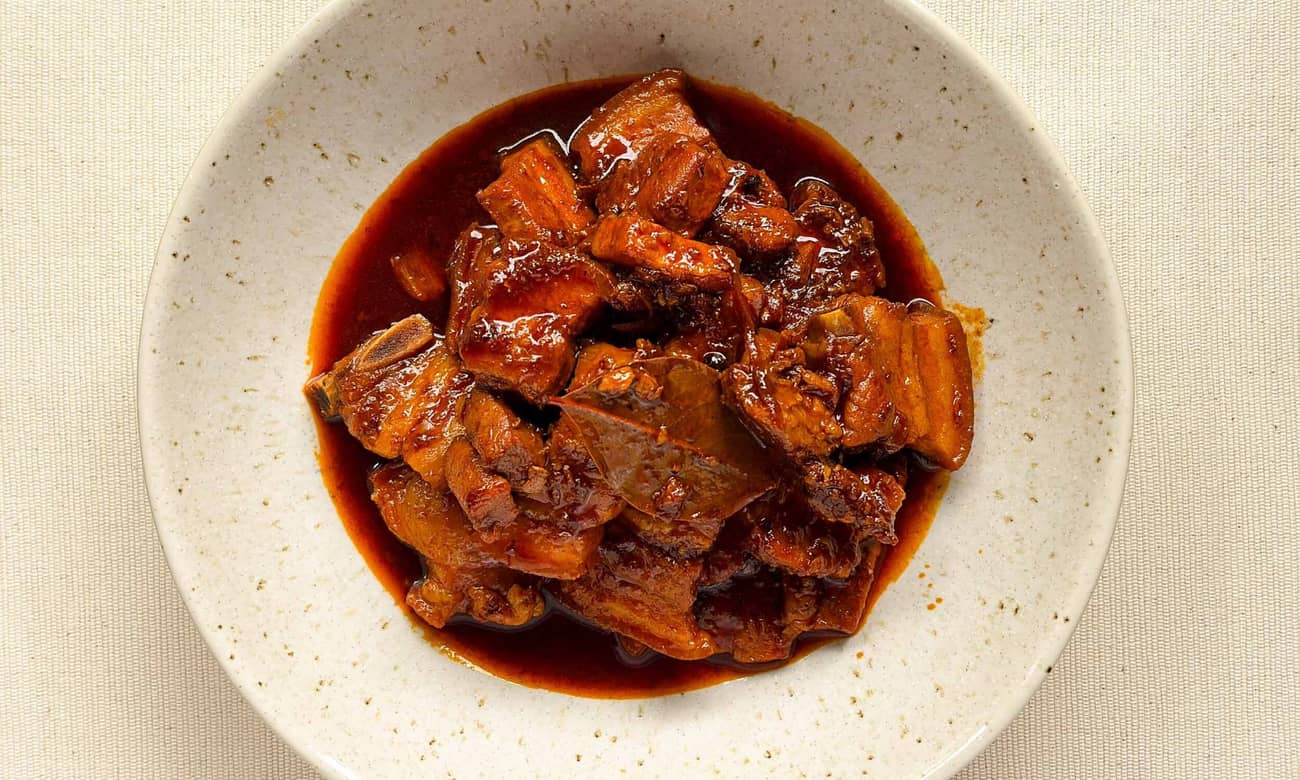
To make adobong Bisaya, pork is braised until tender then fried until crispy. The braising liquid is reduced to make a saucy adobo sawsawan.
What is adobong Bisaya? In Ryle’s household, it’s nagmamantikang adobo: adobo reduced until the sauce has completely evaporated and a film of rendered fat emerges. That fat essentially becomes the sauce of the dish.

Adobo refers to the Filipino dish and cooking technique where ingredients are braised in vinegar with salt (usually soy sauce), garlic, peppercorns, and bay leaves. Almost anything can be adobo: meat, fish, seafood, vegetables. You’ll find endless variations on adobo across the Philippines, each with their own unique flavors, ingredients, spices, and textures.
Other recipes characterize adobong Bisaya by the frying that comes after braising. Once the meat has softened and soaked up the flavorful braising liquid, it’s shallow-fried until crusty all over, forming a crispy bite.
Home cooks who grew up with this style of adobo claim the frying locks in the juices in the pork, making it more flavorful. This is not true.
Frying makes things crispy. And making things crispy requires drying it out, ejecting as much moisture as possible to form a brittle crust.
The pork in your adobo has already lost most of its juices from braising. If you fry it wrong, especially at a temperature below screaming hot, you risk sucking out whatever moisture your pork has left.
So frying your adobo to lock in its juices = false. But that doesn't mean frying your adobo is wrong. It's delicious! You just have to do it right, and use hot oil.
Our tip: Fry your pork in hot, hot oil, to quickly fry the outside without drying out the inside.
An instant-read thermometer will come in handy here. Aim for a temperature between 350–375°F, which will be hot enough to form a crispy crust around your pork without drying out the interior.
Now that your pork is crispy, we're not throwing that back into the liquid you braised it in. In Visayan-style adobo, the braising liquid is reduced into a thick sauce to serve as sawsawan for the crispy pork. Like an adobo-flavored gravy!
This recipe starts off with an adobong puti-style braise of just vinegar and salt. Soy sauce and brown sugar come in later in the sauce reduction stage, imparting a round umami to balance out the tangy fried pork.
Cook pork: Heat oil in a large pan or pot over medium-high heat. Add garlic and black peppercorns. Cook, stirring frequently, until fragrant, about 3 minutes. Add pork liempo, water, vinegar, salt, and bay leaves. Bring to a boil, then reduce heat to medium or medium-low to maintain a simmer. Cover pan and cook pork until tender, about 20–30 minutes.
Make adobo sauce: Uncover pan and remove pork from the braising liquid; set aside. Add soy sauce and brown sugar (if using) to the pan. Increase heat to medium-high and cook, stirring frequently, until sugar is dissolved and liquid has reduced by half and has the consistency of thin gravy. Remove from heat and set sauce aside.
Fry pork: Add neutral oil to a small frying pan until about ½-inch deep. Heat the oil over medium-high, then fry the pork between 350—375°F until golden brown on all sides. The pork is already cooked at this point, so the point of frying is to get it crispy. Make sure your oil is hot so you can fry quickly—not-hot oil will cause your pork to cook longer and soak in the oil.
Transfer fried pork to a paper towel-lined plate to drain excess oil.
Serve: Serve fried pork with steamed rice and adobo sauce on the side. Use the adobo sauce as a dip, or pour it all over your pork as you eat.
Grace Tanfelix (@gracetanfelix) on TikTok inspired this recipe!
